(scroll down for english version)
La prima volta che presi Parigi davvero seriamente fu circa 4 anni fa. Prima di quel momento mi ero sempre dedicata alla capitale francese con una certa costanza ma una totale assenza di pianificazione. L’occasione di un breve week end era vissuta come una visita al Luna Park: mi perdevo per la città ammirandone qualsiasi sfumatura ma con un atteggiamento piuttosto passivo. Mi meravigliavo quando casualmente mi imbattevo in qualcosa di cui avevo letto e che mi aveva interessato, ma non avevo ipotizzato di farlo diventare una meta.
Pormi dei paletti, dei percorsi obbligati, mi è sempre parso limitativo per quello che la città spontaneamente, e in assoluta casualità, poteva offrirmi.
Poi un giorno in libreria ho visto stampato, sulla copertina di un notevole tomo, il faccione sorridente e beffardo di Ducasse nell’atto di mangiarsi con forchetta e coltello una mini Tour Eiffel… e da quel momento nulla è più accaduto “per caso”. J’aime Paris è la raccolta divisa per sezioni dei suoi marchés, restaurants, boulangeries, bistrots e patisseries preferiti di Parigi.
Non restava che prendere una cartina stradale, posizionare delle bandierine e organizzare i percorsi.
Da quattro anni a questa parte Parigi la vivo così, muovendomi come un pac man affamato fra i miei puntini.
Di alcune piacevoli mete parigine che sono diventate per me tappe obbligate ho parlato in Strade di Parigi, ma su Pain de Sucre non ho ancora speso mezza parola. Ingrata.
Ho atteso l’estate per farlo, perché a me Nathalie Robert e Didier Mathray (giovani creatori di prelibatezze dolci e salate con un trascorso di anni sotto l’egida guida del tristellato Pierre Gagnaire) hanno fatto provare più e più volte il gusto del sole, del fresco, del floreale, del cielo pulito, anche nelle fredde giornate di Marzo.
La loro Rosemary è nobiltà, purezza ed eleganza, è voglia di infilarsi un vestito di seta e uscire a camminare sull’erba.
E così ho atteso con pazienza l’arrivo di Giugno, dei lamponi succosi e del croccante rabarbaro. In un caldo pomeriggio ho socchiuso i balconi, preso la mia pentola preferita in ghisa rossa e messo tutto sul fuoco insieme ad un pizzico di magia.
Et voilà.
SUGGERIMENTI
1. É un dessert non particolarmente elaborato ma è importante eseguire con accortezza alcuni passaggi. La crème fraiche (che trovate abbastanza facilmente nei supermercati più riforniti) dev’essere molto fredda nel momento in cui viene montata. Consiglio di farle fare un passaggio in congelatore per una decina di minuti.
2. Prima di versare il cremoso all’orzata sulla composta al rabarbaro sinceratevi che quest’ultimo si sia solidificato. Inoltre preparate il cremoso quando siete certi che la composta è solida perché va versato subito sulla base. Diversamente, se lo lasciate in frigo, si rapprenderà per la presenza della gelatina e poi sarà difficile da versare.
2. Il rabarbaro non è semplice da trovare, per lo meno dalle mie parti: ho chiesto espressamente al fruttivendolo di procurarmene un chilo. Con il quantitativo avanzato ho realizzato qualche vasetto di composta. Il rabarbaro si pela in modo similare al sedano, ma è più semplice e veloce: con un coltellino affilato si parte da una estremità e si scende togliendo la prima “pelle”, quella rossa. In mano vi resteranno delle radici verdi molto croccanti e ricche d’acqua, il gusto da crudo ricorda quello della mela Granny Smith.
3. La forma della torta può essere di qualsiasi tipo. Pain de Sucre realizza delle monoporzione così come dei tranci. Infatti tutte e 3 le preparazioni di cui si compone Rosemary (base, composta al rabarbaro e cremoso) possono essere eseguite separatamente e congelate per poi ssere sformate e assemblate. Chiaramente per fare questo dovete essere in possesso di almeno 3 stampi delle medesime dimensioni. Io non li avevo, perciò ho cotto la base in uno stampo ovale, una volta fredda l’ho sformata e l’ho cinta bene con una striscia di acetato che ho bloccato con un pezzetto di scotch. Ho versato sopra la base la composta al rabarbaro e messo tutto in frigo. Una volta che si è solidificata vi ho versato sopra il cremoso all’orzata e rimesso il tutto in frigorifero. In alternativa potete fare tutto direttamente dentro uno stampo ma per sformare la torta prima sarà necessario congelarla.
STRUMENTI UTILI
robot da cucina o planetaria munita di frusta K e frusta Flexi
mixer ad immersione
stampo a cerchio oppure ovale (alto 5 cm) oppure stampo quadrato (18 cm in larghezza per 5 cm in altezza), a piacere
strisce di acetato
spatola
pentolino
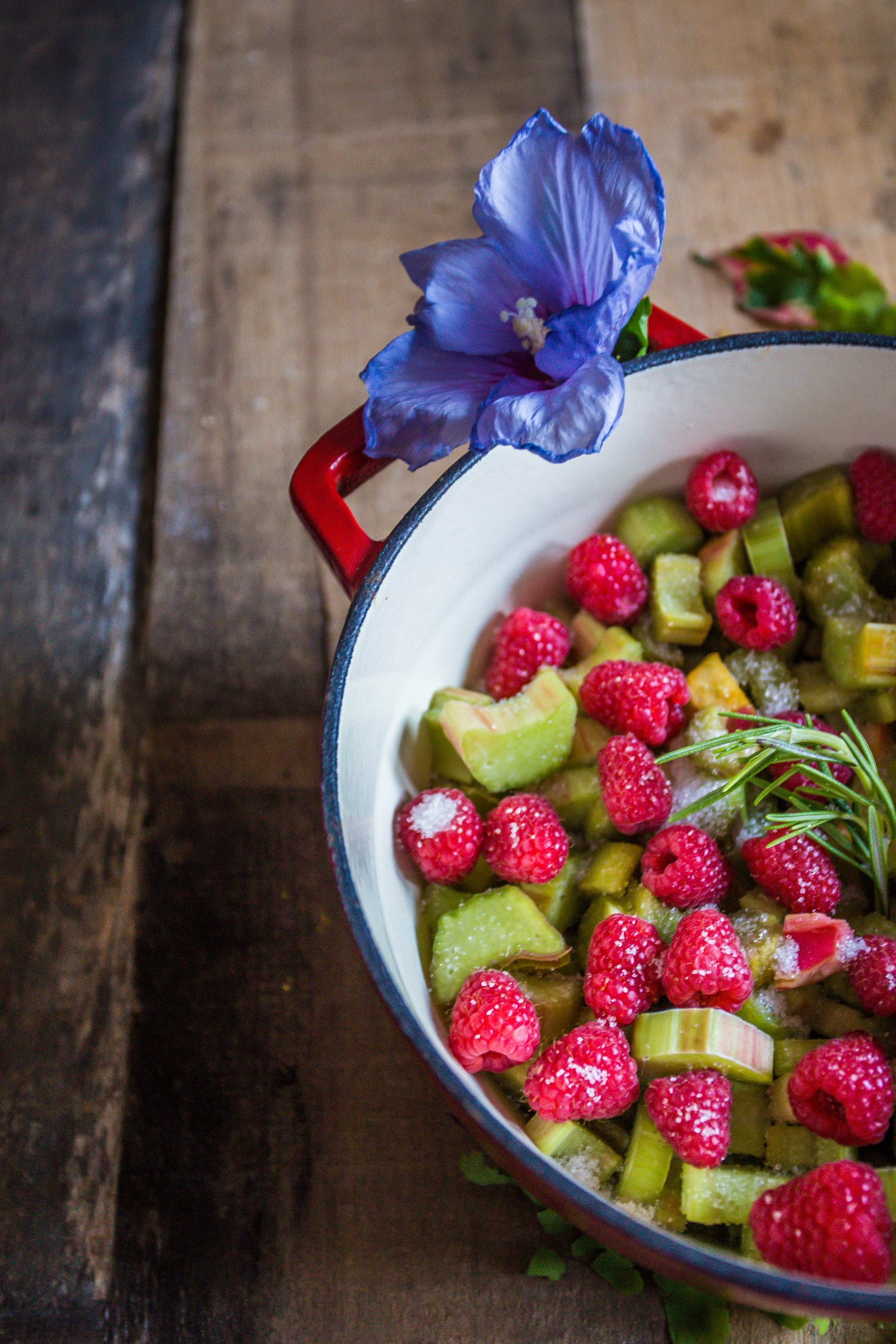
Rosemary
INGREDIENTI&PPROCEDIMENTO
Per la Sablé alla mandorla e rosmarino
80 g burro a temperatura ambiente
90 g farina 00
40 g zucchero a velo
40 g farina di mandorle
2 g fleur de sel
la buccia grattugiata di 1/4 di limone non trattato
5 g rosmarino tagliato finemente
Tritate finemente il rosmarino, e la scorza di limone. Nella ciotola della planetaria mescolate il rosmarino, la boccia di limone, il burro e lo zucchero fino ad ottenere un composto omogeneo e cremoso. Aggiungete la farina 00 e la farina di mandorle. Fate lavorare la macchina solo il tempo necessario affinché tutto sia amalgamato, quindi spegnete, appiattite su pellicola trasparente e riponete in frigo per almeno 1 ora e mezza. Stendete la pasta ad un’altezza di circa 1 cm all’interno del cerchio o dello stampo prescelto appoggiato su una teglia foderata di carta da forno.
Picchiettate con una forchetta la base quindi riponete in forno caldo per circa 15 minuti a 150 °C. Regolatevi con il vostro forno.
Una volta cotto (dovrà avere un colore dorato) lasciate raffreddare bene la pasta prima a temperatura ambiente poi in frigorifero.
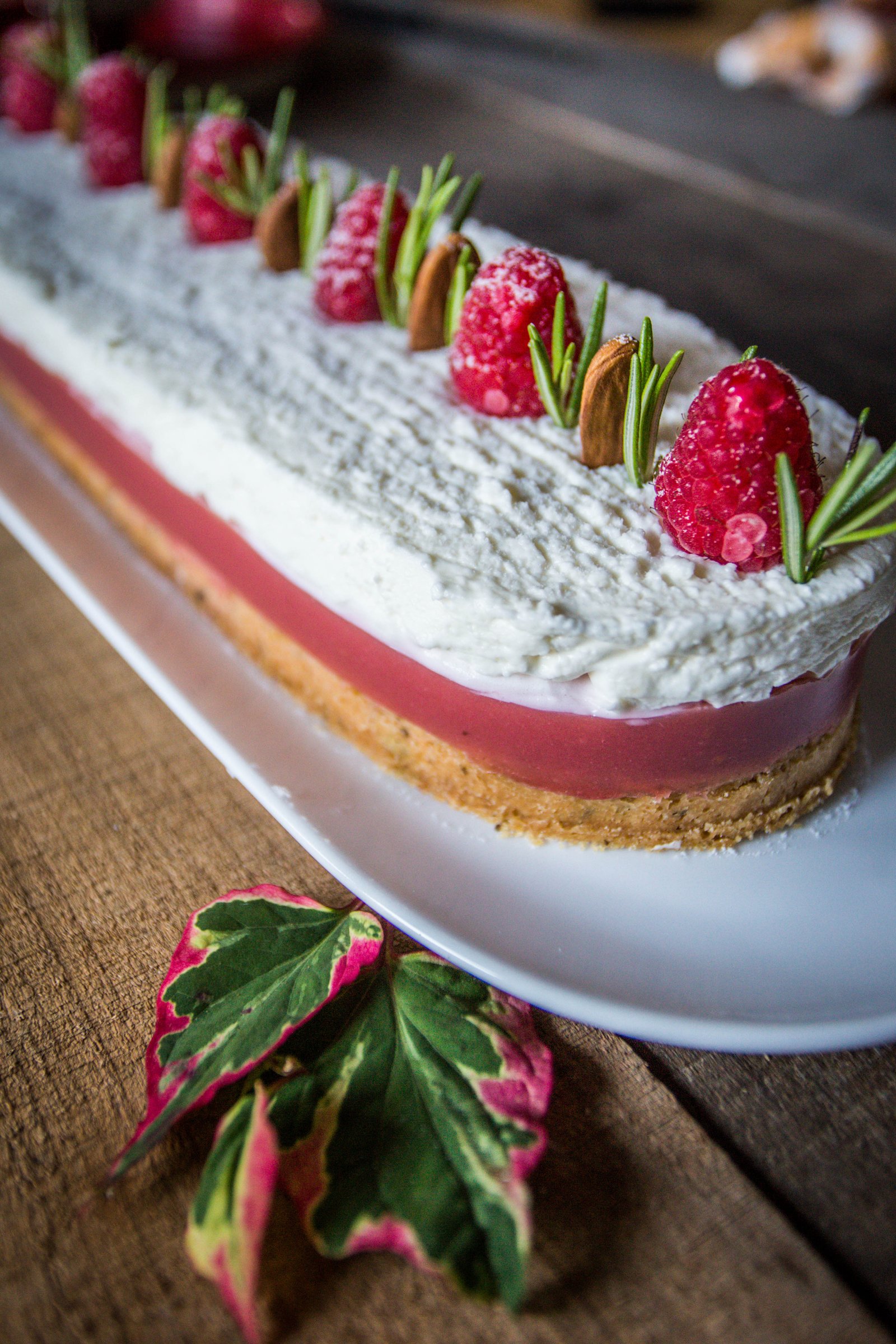
Rosemary
Per la composta al rabarbaro, lamponi e rosmarino
350 g rabarbaro
150 g lamponi
85 g zucchero semolato
1 rametto di rosmarino
8 g gelatina in fogli (circa 4 fogli)
20 g cioccolato bianco tagliato a pezzetti
Lavate le radici di rabarbaro, pelatele e tagliatele in pezzetti di circa 1 cm.
Raccogliete il rabarbaro tagliato, i lamponi, il rametto di rosmarino e lo zucchero in una pentola con coperchio e ponete sul fuoco fino a quando avrete ottenuto una composta morbida e abbastanza asciutta.
Nel mentre, ponete la gelatina in una ciotola piena di acqua fredda affinché diventi morbida.
Inserite un foglio alla volta per evitare che si incollino fra loro.
Quando la composta è pronta, rimuovete il rosmarino e aiutandovi con il mixer frullate il tutto al fine di ottenere una consistenza liscia. Io ho preferito passare la composta allo chinoise (o setaccio) per rimuovere eventuali filamenti.
Aggiungete alla composta ancora calda il cioccolato bianco e la gelatina ben strizzata e mescolate bene.
Lasciate raffreddare a temperatura ambiente quindi versate il composto sopra la base e mettete in frigo a solidificare.
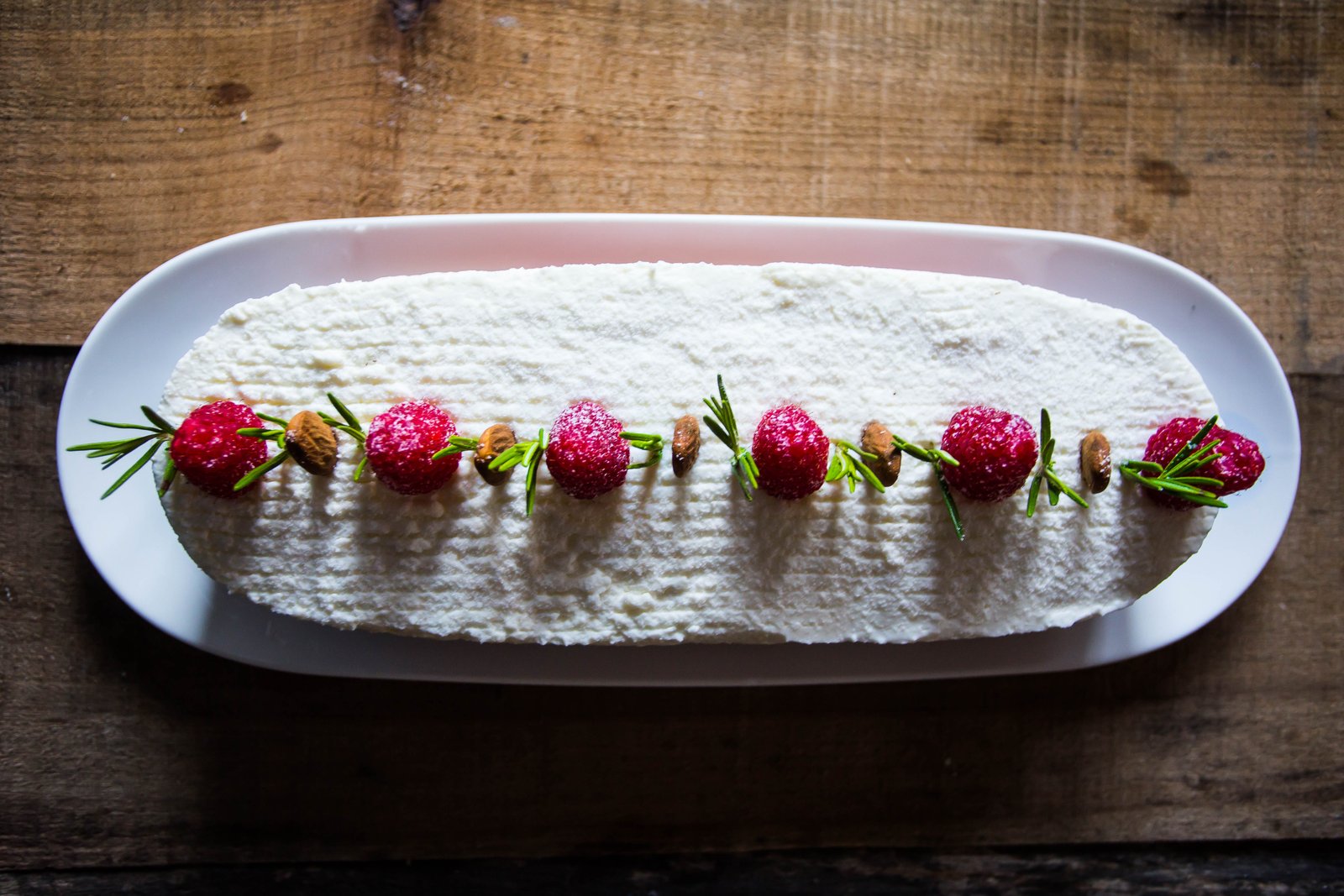
Rosemary
Per il cremoso all’orzata
50 g latte intero
100 g latte di mandorle zuccherato
20 g acqua ai fiori d’arancio
3 g gelatina in fogli (circa 1,5 fogli)
160 g di crème fraiche freddissima
Ponete la gelatina in una ciotola piena di acqua fredda affinché diventi morbida.
Scaldate il latte in un pentolino e, fuori dal fuoco, versateci la gelatina strizzata e mescolate bene. Aggiungete il latte di mandorla, l’acqua ai fiori d’arancio e tenete da parte.
Montate la crème fraiche come fareste con la panna. Incorporate il composto di latte a temperatura ambiente poco alla volta alla crème fraiche montata mescolando con una spatola dal basso verso l’alto.
Versate subito il cremoso all’orzata sulla composta al rabarbaro rappresa e rimettete il tutto in frigo per almeno 1 ora e 30 minuti.
Per la finitura
Guarnite la vostra Rosemary con lamponi, ciuffetti di rosmarino e mandorle.
***
english version
ROSEMARY, RHUBARB’S FRENCH ELEGANCE
It was about 4 years ago when I took Paris seriously for the first time. Before then, I had always devoted myself to the French capital with some consistency, but with a complete lack of planning. I would experience a short weekend away like a visit to a Funfair: losing myself in the admiration of the many shades of the City, but with a rather passive attitude. I would be pleasantly surprised if I accidentally came across something I had read about and that had aroused my interest, but I never thought about making it a destination in the first place.
It seemed restrictive to have a pre-set itinerary, instead of enjoying what the city would randomly and spontaneously offer. Then one day in the bookstore I saw, printed on the cover of a sizeable volume, the large face, smiling and mocking, of Ducasse busy eating a mini Eiffel Tower with fork and knife … and from that moment, nothing more happened “by chance”. J’aime Paris is the collection, divided by sections, of his favorite marchés, restaurants, boulangeries, bistrots and patisseries in Paris.
All that was left to do was take a map, place a few flags and arrange the routes. This is how I have been experiencing Paris in the past 4 years: running like a hungry Pacman between dots. I spoke in Strade di Parigi (Streets of Paris) of some lovely destinations which have become obligatory spots for me, but I haven’t yet spent a single word on Pain de Sucre. Ungrateful. I waited until summer to do it, because thanks to Nathalie Robert and Didier Mathray (young creators of sweet and savory delicacies who spent years under the guidance of tri-starred Pierre Gagnaire) I’ve experienced over and over the taste of sun, the freshness, of flowers, of clean air, of clear sky, even on a cold March day. Rosemary is nobility, purity, elegance; it’s the desire of wearing a silk dress and go out walking on the grass.
And so I waited patiently for the arrival of June, of juicy raspberries and crunchy rhubarb. On a hot afternoon I set the balconies ajar, took my favorite cast iron casserole pan and put it on the stove along with a touch of magic.
Et voilà.
TIPS
1. While it’s not a particularly elaborate dessert, it’s important that some steps are carefully executed. The crème fraiche (easy enough to find in a well-stocked supermarket) must be very cold when it’s being whipped. I recommend placing it in the freezer first for about 10 minutes.
2. Make sure that the crémeux à l’orgeat has solidified before pouring it onto the rhubarb mixture. In addition, only prepare the crémeux once you’ve verified that the mixture is firm because you must pour it immediately onto the base. Otherwise, if left in the fridge, it will coagulate due to the gelatin and it will be difficult to pour.
3. Rhubarb is not easy to find, at least where I live; I expressly asked the greengrocer to get one kg of it for me. With the leftovers I made a few jars of jam. Rhubarb is peeled in the same way as celery, but it’s easier and faster: with a sharp knife, starting from one end, peel down the first layer of skin, the red one. You’ll obtain green stalks, crunchy and rich in water; when raw, the taste reminds a bit that of a Granny Smith apple.
4. This cake is suited to any type of shape. Pain de Sucre makes single portions or slices. Indeed, all three preparations of Rosemary (base, rhubarb mixture and cremoso) can be made separately and frozen, and then taken out of the mold and assembled together. Obviously to do it this way you need three identical molds. Since I didn’t have them, I baked the base in an oval-shaped mold, once cold I took it out and wrapped it tightly with an acetate strip held together with some Scotch tape. I poured the rhubarb mixture onto the base and placed everything in the fridge. Once firm, I added the cremoso all’orzata and put everything back into the fridge. Alternatively, you can do everything in one mold, but you’ll need to freeze the cake before removing it from the mold.
USEFUL TOOLS
Food mixer or Kitchen Machine with K-beater or flat beater
Hand blender
Round or oval mold (5cm high) or square mold (18cm long and 5 cm high)
acetate strips
spatula
small pan
INGREDIENTS & METHOD
80 g butter at room temperature
90 g flour 00
40g icing sugar
40g almond flour
2 g fleur de sel
Grated zest of ¼ lemon (organic)
5 g rosemary, finely chopped
For the almond and rosemary Sablé
Finely chop the rosemary and the lemon zest. Add them to the bowl of the KitchenAid and mix them together with the butter and sugar until you obtain a uniform and creamy mixture. Add the 00 flour and almond flour. Mix only for as long as it takes to combine all ingredients together, then turn off the mixer, flatten the mixture onto cling film and put it in the fridge for at least 1.5 hour.
Line the mold with parchment paper and pour the mixture so that it’s about 1 cm thick.
Pinch the base with a fork then put in the oven, pre-heated to 150 °C. Once ready – it should be of a golden color, the time will vary depending on your oven – let the base cool down first at room temperature, then in the fridge.
For the rhubarb, raspberry and rosemary mixture
350 g rhubarb
150g raspberries
85g castor sugar
1 branch rosemary
85 g gelatine (approx. 4 sheets)
20 g white chocolate, chopped
Wash the rhubarb stalks, peel them ad cut them into pieces about 1 cm thick. Add them to a casserole pan together with the raspberries, the rosemary branch and the sugar, and cook everything until you obtain a soft and dry enough compote.
In the meantime, place the gelatin to soften in a bowl of cold water, one sheet at the time to avoid them sticking to each other. When the mixture is ready, remove the rosemary and with a hand blender whizz it all together until you obtain a smooth texture. I prefer to use a chinois or a sieve to get rid of any fibers. While the compote is still hot, add the white chocolate and the gelatin (squeeze it well beforehand) and mix it all together. Let it cool down at room temperature, then pour the mixture over the base and put it back in the fridge to firm up.
For the crémeux à l’orgeat
50 g full fat milk
100 g sweetened almond milk
20 g orange blossom water
3 g gelatin sheets (approx. 1.5 sheets)
160 g crème fraiche, it must be very cold
Place the gelatin to soften in a bowl of cold water. Warm up the milk in a small pan, remove from the heat and add the squeezed gelatin, mixing well. Add the almond milk, the orange blossom water and set aside. Whip the crème fraiche like you would do with cream. Once the milk mixture has reached room temperature, slowly incorporate it to the whipped crème fraiche, working with a spatula from the bottom to the top.
Immediately pour the cremoso all’orzata on the rhubarb mixture and put it back in the fridge for at least 1.5 hour.
Finishing touches
Decorate your Rosemary with raspberries, rosemary leaves and almonds.



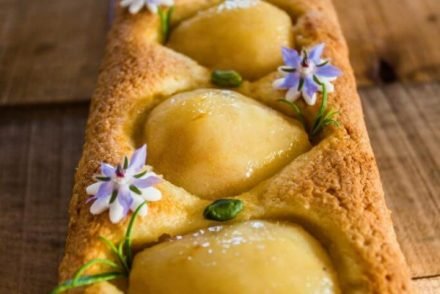

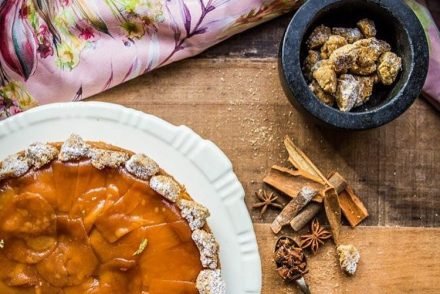

Nessun commento